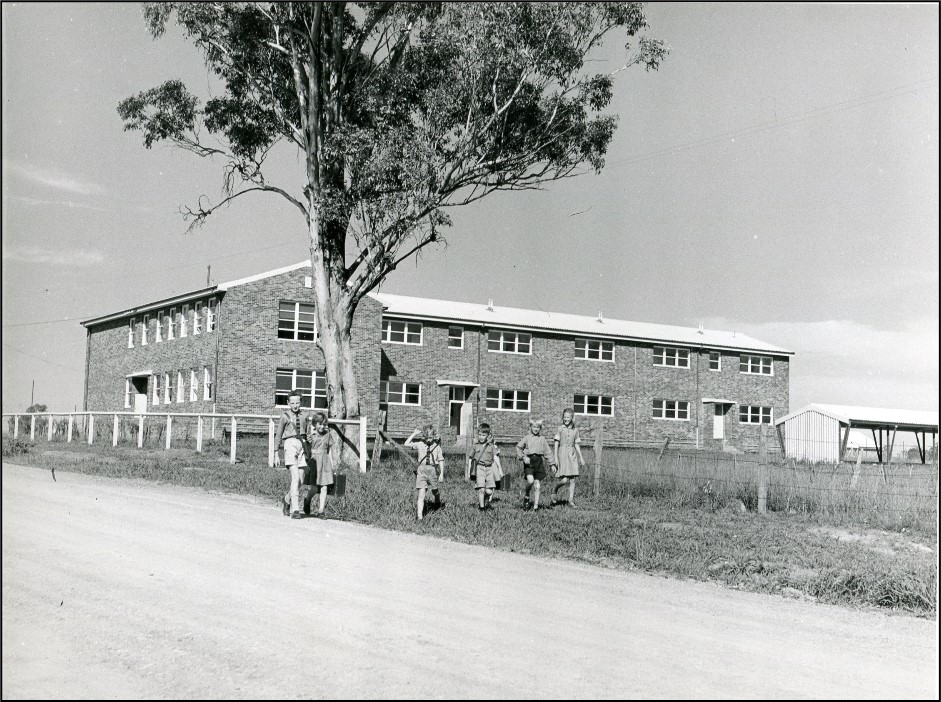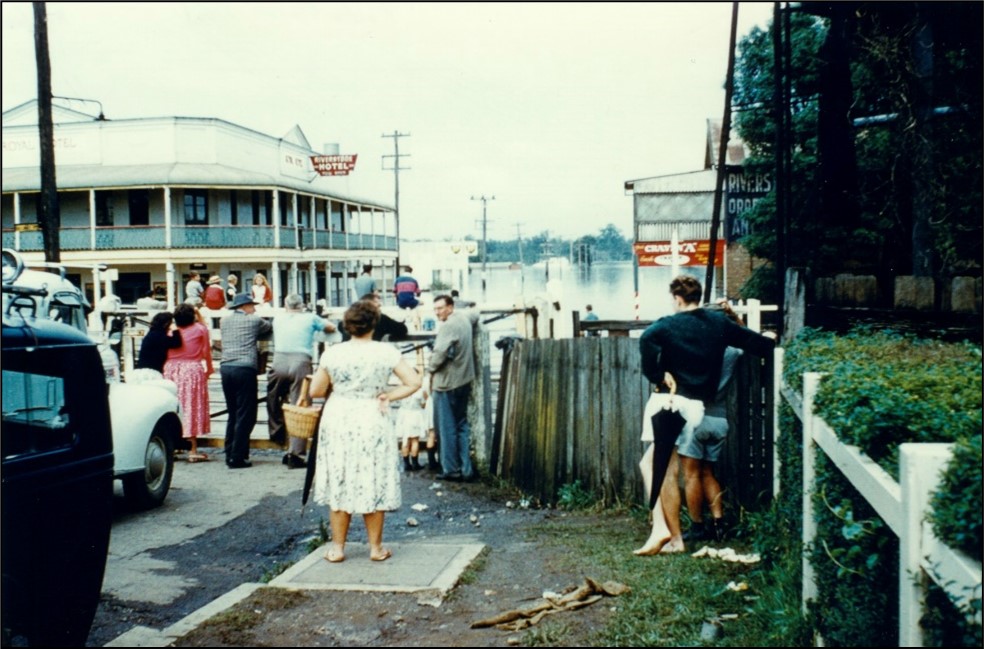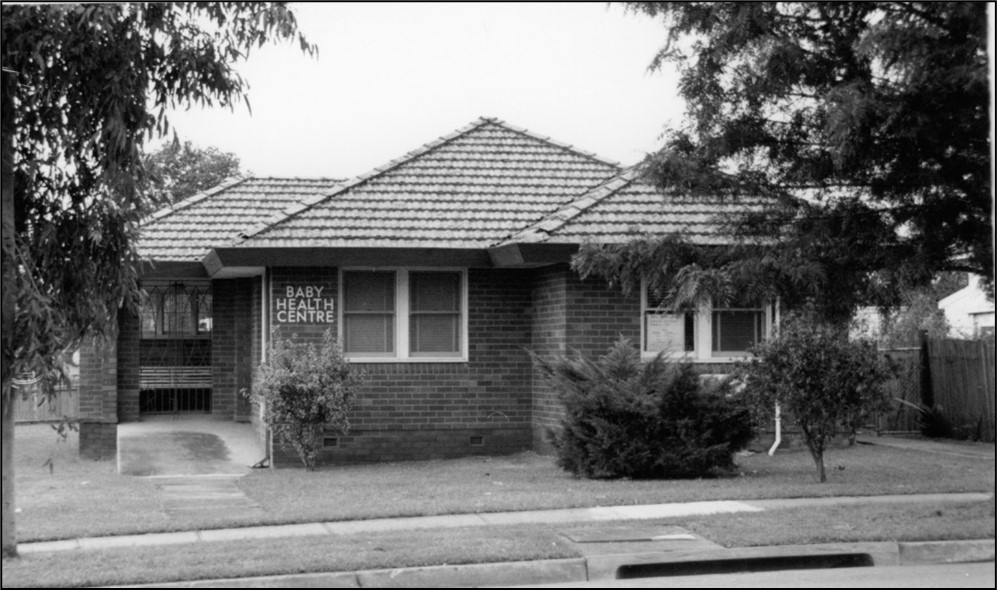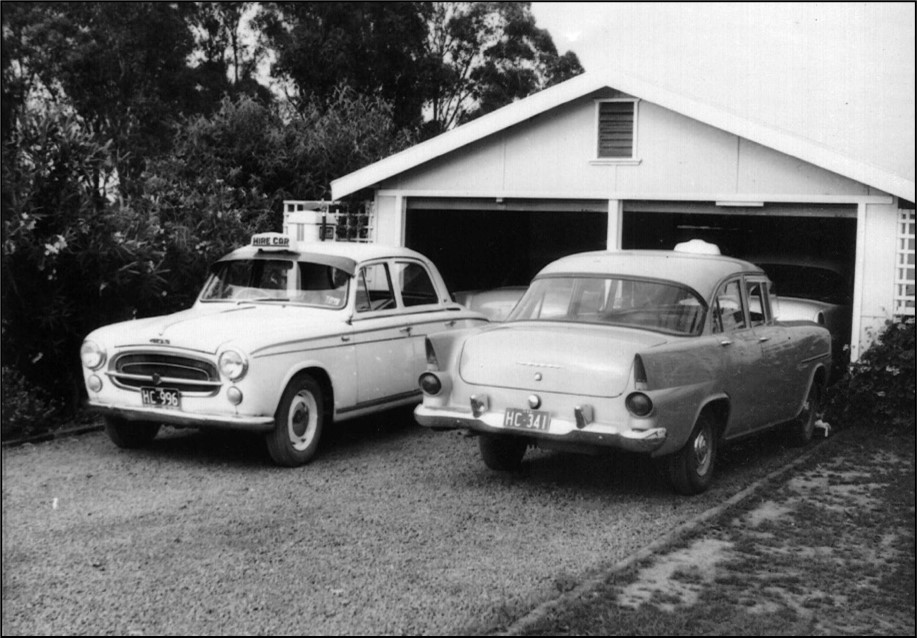by Wendy Biddle
The year was 1949, and the little girl was pushing her pram from the railway to her new abode. The last couple of nights she had been sleeping in the storage shed opposite the railway station as her father had been transferred with the railway. As a four- year old she remembered the yellow calliopsis flowers swaying in the grass as the train went by and fettlers pushing their trikes along the tracks. In later years, the little girl would look out the train window for the Griffith Bros tea sign which indicated how many miles to the city of Sydney. The family walked up Regent Street to their home which was on a huge corner block and two blonde haired girls came across the road and wanted to play, but she was too shy. The family had come from a small hamlet in the northwest called Baan Baa, but only her two siblings would remember her birthplace.
Their new town was a rural community called RIVERSTONE or Rivo as it was known by the locals. It was a far cry from their previous domicile where red dirt wedged between their toes and drifted in the hot wind.
Dirt roads were still the norm, and when it started to rain she could literally smell the rain coming as it settled the dust but when the storm came it became a slippery quagmire. There weren’t many houses then and therefore if you were going to the shops you cut through paddocks with knee high paspalum that stuck to your socks and it made you itch. There were big muddy puddles and heaven knows how many snakes. That thought never entered your head. Attending the Olympia Theatre at night, which most of the townsfolk seemed to do, you walked home the same way. At interval, you went to Blair’s Milk Bar, George Trahanis, and Tony’s, who made the best hamburgers, or the Wattle Milk Bar for refreshments. The latter always had those yellow insect strips hanging from the ceiling to keep the bugs off the food.
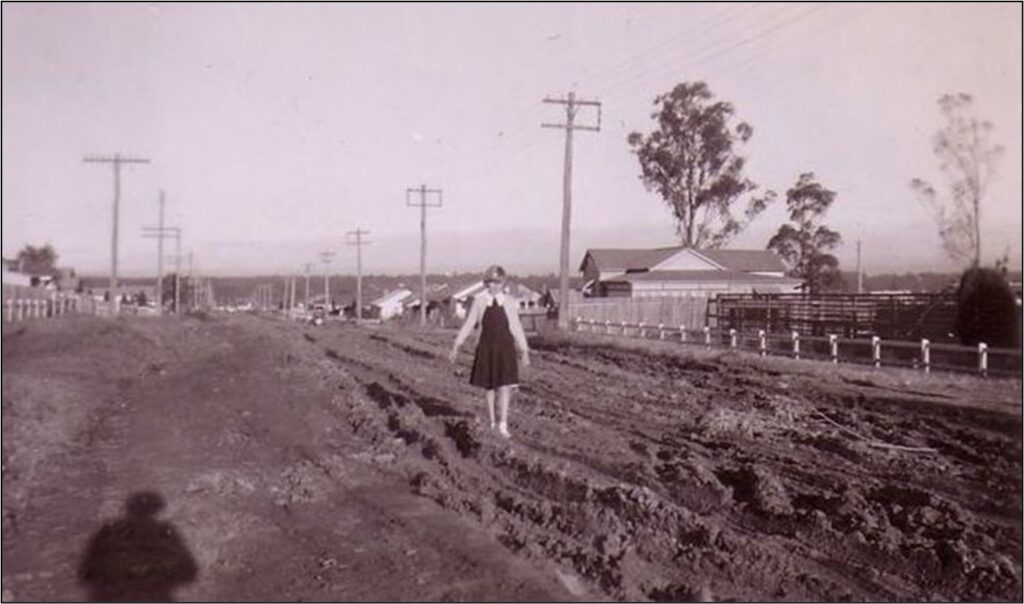
Photo: Wendy Biddle
The Big W of the town was Rosenthall’s and they sold everything, clothes hardware, groceries, lawnmowers – you name it you could get it at this shop. There was also Arnold’s, Mrs. Coulters and in later years Noni B for clothes. Wood’s grocery shop was interesting as they had items on tables and you bought a bag of broken biscuits, because they were cheaper or half a pound of flour as the goods were in big tins or sacks. The customers carried their shopping in string bags and by the time they arrived home it was nearly on the ground from the weight.
The local vegetable shop was Stacy’s, and they had a truck that came around to sell their wares and Fishers Bakery had a horse and cart that delivered. The lucky person who went to collect the bread usually took the middle out as it was still warm. The same for the milk they rode their bikes to Martin’s dairy for a quart of unpasteurized milk in a billycan. Most times they had less when they arrived home especially if the children went to shop. The schoolchildren had little bottles of milk for recess and there was always a layer of cream at the top. Unfortunately the shed where it was stored faced the east and it was hot and uninviting! Speaking of schools there were two – the public in Garfield Road and the catholic School in the church grounds. The little girl, who never enjoyed any of her schooling years, was to attend the public carrying her little Globite schoolcase. Pupils sat at small desks with inkwells and used pencil to learn cursive writing, and when they progressed to pen they practiced between the sloped lines. They learnt reading, writing and arithmetic or the 3R’s as it was then known, and most of the children became proficient in all subjects. The students all lined up at the original school which is now a museum to have their Sabin vaccine for Poliomyelitis, Mantoux test for Tuberculosis and diphtheria injections. The little girl can recall a 6th grade student checking the children for head lice with the same ruler for each child. There was also a school concert held occasionally at the Olympia Theatre as there were no facilities for the sort of occasion.
Both schools had religious instruction and the Catholic children always wore a brown leather necklace called a scapular with the picture of Our Lady of Mount Carmel on one side and St. Simonstock on the other. The little girl was told this meant they would always be blessed. All the children were covered in Vicks in the winter to ward off colds. Sport was a weekly event and quite often marching around the asphalt. The children certainly knew their left foot from their right and no trouble keeping in time if they were to march in the Anzac Day parade. Unfortunately this was the era where the cane was still given and many children would remember this vividly even if they didn’t receive the punishment. They mostly rode their bikes to school and if they needed attention Danny Mason was the man to see.
A new Post Office had been built and it had a manual exchange and there were red telephone booths and postal boxes scattered around the area.
There were four churches in the town – the Church of England, Presbyterian, where the little girl admired the freesias around the trees, Catholic and the Methodist which is the only one not in use, now it is a second hand shop.
The bells always tolled at the Church of England when there was a funeral or a wedding and if it was the latter, townsfolk would go to the church and have a look as they most probably knew the bride and groom.
Conway’s Newsagency was opposite the railway station and there was a barber’s shop at the rear. Funeral notices were posted in their window for all to see and it was a good way for the town to keep in touch. Election Day was an outing and everyone was dressed up in their Sunday best to go and vote and the CWA ladies most probably had a stall – no sausage sizzles in those days.
Who could forget the grand old Royal Hotel near the railway gates – it was demolished in later years and a new hotel was built. The floodwaters have been known to come up to the railway gates and over the line further towards the meatworks. These waters were very worrying for the trains as the flood used to come up really high under the viaduct at Mulgrave. However, many fun times were had by the schoolchildren who had to travel to Richmond High School via train as there were no senior schools in Riverstone.
The railway gates and signals were opened manually to allow the traffic to flow and two metal staffs had to be transferred from the station master to the guard on the train and that was their indication that the line was clear. There was a huge water tank for the trains to fill up and you could see plumes of steam and smoke drifting over the district as the train made its way to Richmond or Blacktown. Occasionally they had the country trains which had double doors and corridors and pictures on the wall of places around the country. There was also a rack which had water bottles and glasses. These could be refilled at Central Station where the porters would be pushing the carts around the station. Electrification finally came in 1975 and everybody came out to have a look and take photos.
Employment was mostly at the local meatworks and if you didn’t have a permanent job you went on the gate and hoped for a casual position for the day if you were lucky enough. People would come in droves off the train in the hope of getting a day’s salary. The whole town used the works siren as a clock to signify when it was start time or lunch etc. The stock were brought in by train and the stockmen unloaded and put them into yards at various times so they were ready for the kill next day. When there was a tragic fire the community mourned as these were hardworking local people that had been earning a living to support their families.
The local stock and station agent was Taylors, which was between the railway and the meatworks and they sold their grain in bulk. The employees had to carry huge sacks on their shoulders and always wore leather aprons. Another person who wore an apron was Eric Brookes, he was the local shoe repairer on the corner of Market Street and moved to the main street in later years and if you couldn’t get shoes out of town you could guarantee he had them on your return.
Riverstone had two doctors – Dr. Carroll and Dr. Fraser – Boag and he lived in a lovely old dark brick home with a wide verandah. The dentist was in Mill Street and the mothers used to take their babies to the Baby Health Centre to have them checked and make sure they were growing. The Sister at the Clinic would tell them when to start the babies on solids. The local pharmacy was in Garfield Road and Chemist Williams remained there for quite some time.
There was a taxi service run by Aub Gillespie and the local bus was Barnes Bus Company and Ampol Garage and it was good when you could go by transport other than your legs! The local constabulary was a one manned station in Railway Terrace and it was undersized with maybe one cell for the inebriated to sober up overnight. This was later to be moved to Australiana Village at Wilberforce. Two banks, the Commonwealth and the Commercial Banking Corporation, ensured the town was well accounted for.
Immense backyards enabled the children to play until dark with their friends – parents didn’t worry as they knew they would be home at some point. The little girl played fly which was jumping between sticks, hopscotch, marbles and jacks. The girls across the road became friends and a lot of the time they tied a rope to the squeaky gate and skipped. There was also the Riverstone Park which had a slippery dip, a hurdy-gurdy that went around and also a seesaw, but strangely enough there was always a puddle of water somewhere when you fell off. The slippery dip was shiny and hot in summer! As there was no swimming pool it was not uncommon for people to go to the Hawkesbury River at Bungool but the families would load onto the back of the neighbour’s truck and hang on – all part of growing up in the 1950s.
The little girl has remained in her town her whole life. Sometimes she has been mocked as to why she would live here and her answer – “Because I am proud of my town.”
After leaving school, where she achieved well, she was employed after leaving High School, married and enjoyed her family and is now a proud grandmother. Friendships made over the years have remained, even from school days. That in itself is wonderful and even though she may pine for days gone by there are lots of memories.
Like many of the older generation, the little girl sometimes wishes that Riverstone was the same as it was in the early days. There has been a lot of progress and hundreds of homes have been built to the point that she can forget where things used to be. The urban settlement seems to be at a standstill and back in the early days you could buy most of what you needed in the town without travelling further afield.
The old saying “Progress waits for no one” is so true.
The little girl’s identity – Wendy Biddle nee Coates.
This article was an entry in the 2019 Blacktown City Council Mayoral History Prize. The article also appeared in the Feb 2020 – Mar 2020 edition of the Colo Shire Family History Group Inc. magazine. We thank Wendy for allowing us to include her story in our Journal.

